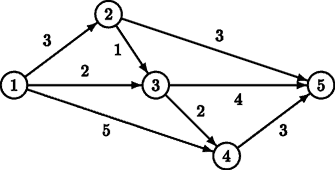383. 观光(dp思想运用,Dijkstra)
“您的个人假期”旅行社组织了一次比荷卢经济联盟的巴士之旅。
比荷卢经济联盟有很多公交线路。
每天公共汽车都会从一座城市开往另一座城市。
沿途汽车可能会在一些城市(零或更多)停靠。
旅行社计划旅途从?S?城市出发,到?F?城市结束。
由于不同旅客的景点偏好不同,所以为了迎合更多旅客,旅行社将为客户提供多种不同线路。
游客可以选择的行进路线有所限制,要么满足所选路线总路程为?S?到?F?的最小路程,要么满足所选路线总路程仅比最小路程多一个单位长度。

如上图所示,如果?S=1,F=5,则这里有两条最短路线?1→2→5,1→3→5,长度为?6;有一条比最短路程多一个单位长度的路线?1→3→4→5,长度为?7。
现在给定比荷卢经济联盟的公交路线图以及两个城市?S?和?F,请你求出旅行社最多可以为旅客提供多少种不同的满足限制条件的线路。
输入格式
第一行包含整数?T,表示共有?T?组测试数据。
每组数据第一行包含两个整数?N?和?M,分别表示总城市数量和道路数量。
接下来?M?行,每行包含三个整数?A,B,L,表示有一条线路从城市?A?通往城市?B,长度为?L。
需注意,线路是?单向的,存在从?A?到?B?的线路不代表一定存在从?B?到?A?的线路,另外从城市?A?到城市?B 可能存在多个不同的线路。
接下来一行,包含两个整数?S?和?F,数据保证?S?和?F?不同,并且?S、F?之间至少存在一条线路。
输出格式
每组数据输出一个结果,每个结果占一行。
数据保证结果不超过?109。
数据范围
2≤N≤1000,
1≤M≤10000,
1≤L≤1000,
1≤A,B,S,F≤N
输入样例:
2
5 8
1 2 3
1 3 2
1 4 5
2 3 1
2 5 3
3 4 2
3 5 4
4 5 3
1 5
5 6
2 3 1
3 2 1
3 1 10
4 5 2
5 2 7
5 2 7
4 1
输出样例:
3
2解析:
最短路径的条数。
如果存在比最短路径长度恰好多1的路径,则再把这样的路径条数加上。
状态划分:不重不漏,将状态转移所依据的状态体现出来;
d[i,0]表示从1到i的最短路径距离,cnt[i,0]最短路径条数
d[i,1]表示从1到i的次短路径距离,cnt[i,1]次短路径条数
这里还是和之前的题目一样,将d[i,0]和d[i,1]两种状态看成两个点。
重点解决:d[i,1]表示从1到i的次短路径,具体看代码处理。
本题很好,非常值得回味!
#include<iostream>
#include<string>
#include<cstring>
#include<cmath>
#include<ctime>
#include<algorithm>
#include<utility>
#include<stack>
#include<queue>
#include<vector>
#include<set>
#include<math.h>
#include<map>
#include<sstream>
#include<deque>
#include<unordered_map>
using namespace std;
const int N = 1e3 + 5, M = 1e4 + 5;
struct Ver {
int ver, type, dist;
bool operator > (const Ver& W) const {
return dist > W.dist;
}
};
int n, m, S, T;
int h[N], e[M], w[M], ne[M], idx;
int dist[N][2], cnt[N][2];
int vis[N][2];
void add(int a, int b, int c) {
e[idx] = b, w[idx] = c, ne[idx] = h[a], h[a] = idx++;
}
int Dijkstra() {
memset(dist, 0x3f, sizeof dist);
memset(cnt, 0, sizeof cnt);
priority_queue<Ver, vector<Ver>, greater<Ver>>heap;
dist[S][0] = 0, cnt[S][0] = 1;
heap.push({ S,0,0 });
while (!heap.empty()) {
Ver t = heap.top();
heap.pop();
int ver = t.ver, type = t.type, d = t.dist, count = cnt[ver][type];
if (vis[ver][type])continue;
vis[ver][type] = 1;
//cout << "__________________________________" << ver << endl;
for (int i = h[ver]; i != -1; i = ne[i]) {
int j = e[i];
//cout << "++++++++++++++++++" << j << endl;
if (dist[j][0] > d + w[i]) {
dist[j][1] = dist[j][0];
cnt[j][1] = cnt[j][0];
heap.push({ j,1,dist[j][1] });
dist[j][0] = d + w[i];
cnt[j][0] = count;
heap.push({ j,0,dist[j][0] });
}
else if (dist[j][0] == d + w[i]) {
cnt[j][0] += count;
}
else if (dist[j][1] > d + w[i]) {
dist[j][1] = d + w[i];
cnt[j][1] = count;
heap.push({ j,1,dist[j][1] });
}
else if(dist[j][1] == d + w[i]) {
cnt[j][1] += count;
}
}
}
int ret = cnt[T][0];
if (dist[T][1] == dist[T][0] + 1)ret += cnt[T][1];
return ret;
}
int main() {
int TT;
cin >> TT;
while (TT--) {
memset(h, -1, sizeof h);
memset(vis, 0, sizeof vis);
idx = 0;
scanf("%d%d", &n, &m);
for (int i = 1, a, b, c; i <= m; i++) {
scanf("%d%d%d", &a, &b,&c);
add(a, b, c);
}
scanf("%d%d", &S, &T);
printf("%d\n", Dijkstra());
/*cout << endl << endl;
for (int i = 1; i <= n; i++) {
cout << dist[i][0] << " ";
}
cout << endl;
for (int i = 1; i <= n; i++) {
cout << cnt[i][0] << " ";
}
cout << endl<<endl;
for (int i = 1; i <= n; i++) {
cout << dist[i][1] << " ";
}
cout << endl;
for (int i = 1; i <= n; i++) {
cout << cnt[i][1] << " ";
}
cout << endl;*/
}
return 0;
}
本文来自互联网用户投稿,该文观点仅代表作者本人,不代表本站立场。本站仅提供信息存储空间服务,不拥有所有权,不承担相关法律责任。 如若内容造成侵权/违法违规/事实不符,请联系我的编程经验分享网邮箱:chenni525@qq.com进行投诉反馈,一经查实,立即删除!
- Python教程
- 深入理解 MySQL 中的 HAVING 关键字和聚合函数
- Qt之QChar编码(1)
- MyBatis入门基础篇
- 用Python脚本实现FFmpeg批量转换
- 【软件测试】如何设计自动化测试脚本
- 【LeetCode】哈希表精选5题
- Js中直接修改原数组的方法
- 阿里云服务器哪个地区最佳?地域选择的影响因素与建议
- Flink 2.0 状态管理存算分离架构演进
- java数据结构与算法刷题-----LeetCode645. 错误的集合
- Python私有变量的定义与访问
- vue项目表单使用正则过滤ip、手机号
- 会声会影2024旗舰版有哪些新功能?好不好用
- Python实现简单的JS逆向解密, 实现翻译软件+语音播报